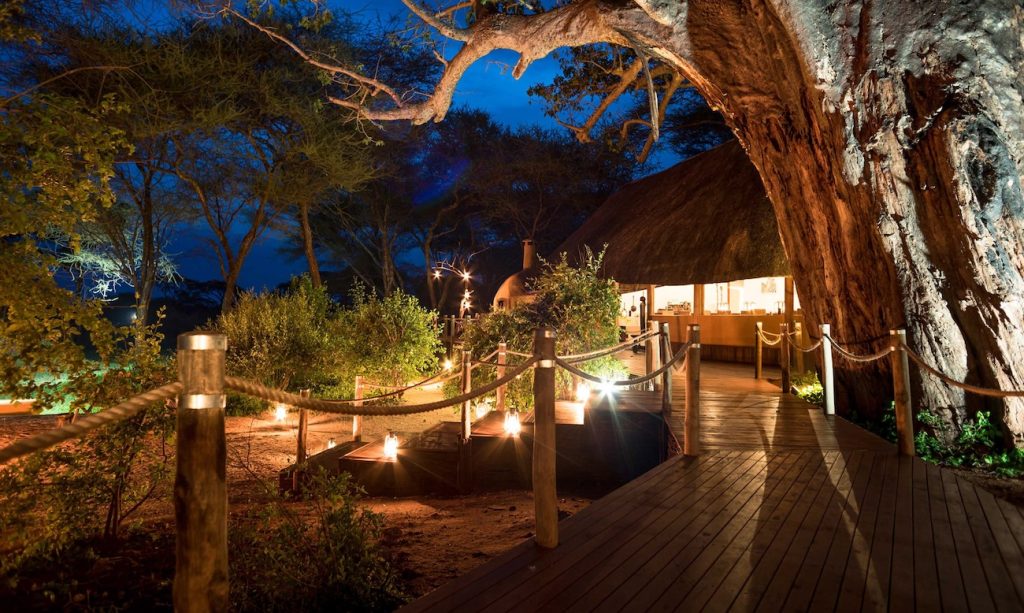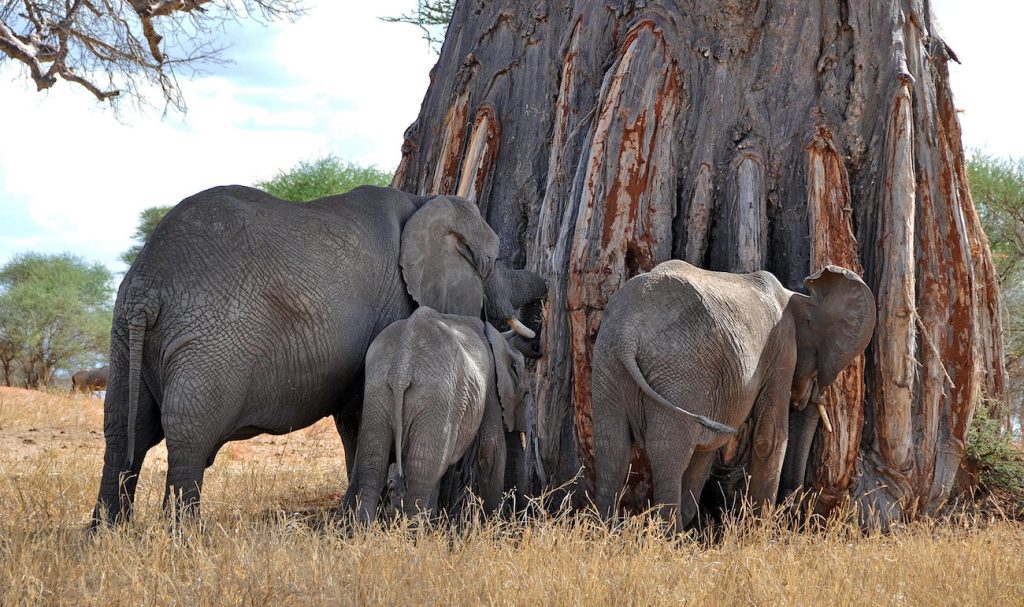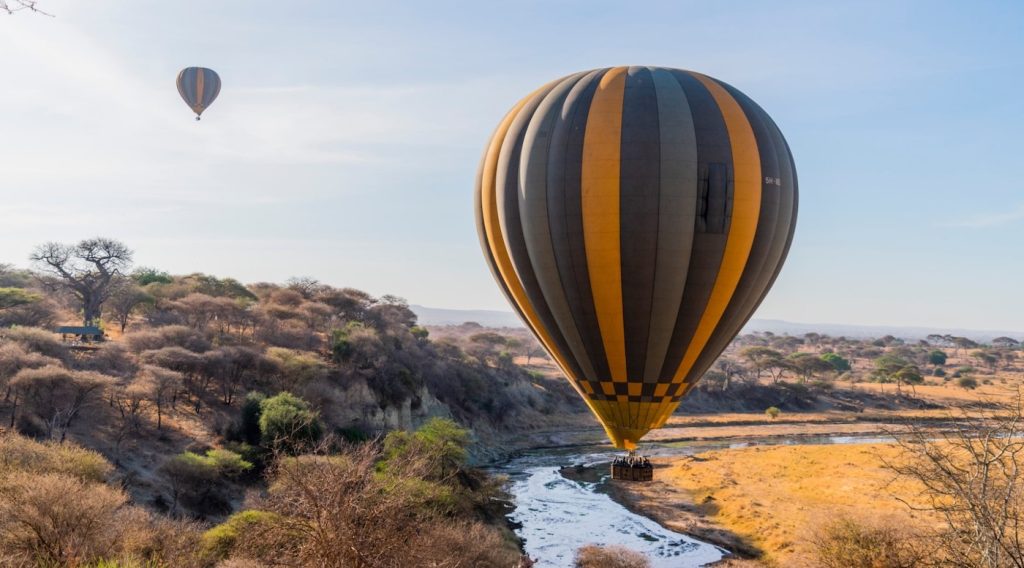The Wildlife of Tarangire National Park
Tarangire’s a wildlife jackpot, especially if you love elephants—they’ve got the world’s biggest concentration here, with herds hitting 3,000 in peak season.
The dry months (June to October) bring a mini-migration of wildebeest, zebras, and buffalo, crowding the riverbanks and lagoons. Predators like lions (over 700 strong), leopards, and cheetahs stalk the scene, some lions even climbing trees—a quirky twist you won’t see everywhere. Look out for oddballs like the fringe-eared oryx, gerenuk, and dwarf mongoose hiding in old termite mounds. Birders lose it over the 550+ species, from lovebirds to massive kori bustards. It’s not full-on Big Five (no rhinos), but the variety’s wild.
Checklist for common animals in Tarangire
| Animal |
Description |
| African Elephant |
Massive herds (up to 300) roam the plains, digging riverbeds for water in dry season. |
| Lion |
Tree-climbing kings, over 700 roam here, often spotted near swamps or acacias. |
| Leopard |
Sneaky cats hiding in thick bush or trees, rare but thrilling to catch. |
| Cheetah |
Speedy hunters on the plains, less common but a prize sighting. |
| Spotted Hyena |
Cackling scavengers, active at dusk, scavenging kills or hunting in packs. |
| African Buffalo |
Big herds thunder across grasslands, sticking close to water sources. |
| Zebra |
Black-and-white grazers, migrating in thousands during dry season. |
| Wildebeest |
Shaggy migrators, joining the dry-season rush to the Tarangire River. |
| Masai Giraffe |
Towering leaf-munchers, browsing acacias with their long necks. |
| Fringe-Eared Oryx |
Rare antelope with long horns, a dry-country gem if you spot one. |
| Gerenuk |
Long-necked antelope standing on hind legs to eat, super elusive. |
| Greater Kudu |
Stately antelope with spiral horns, hiding in woodlands. |
| Waterbuck |
Musky antelope near rivers and swamps, easy to spot by water. |
| Impala |
Graceful leapers in big groups, a predator’s favorite snack. |
| Grant’s Gazelle |
Sleek grazers on open plains, quick to bolt at danger. |
| Olive Baboon |
Noisy troops foraging everywhere, from trees to open ground. |
| Vervet Monkey |
Cheeky gray monkeys swinging through acacias, always up to something. |
| Warthog |
Tusked diggers rooting in the dirt, often seen trotting with tails up. |
| African Wild Dog |
Endangered painted wolves, rare packs hunting in the south—pure luck to see. |
| Dwarf Mongoose |
Tiny, social critters living in termite mounds, darting around fearlessly. |
Checklist for Birds available at Tarangire National Park
| Bird |
Description |
| Yellow-Collared Lovebird |
Tiny, bright parrots flitting in flocks, an endemic Tanzanian treat. |
| Lilac-Breasted Roller |
Flashy blue-and-purple flier, perching on branches like a living jewel. |
| Kori Bustard |
Africa’s heaviest flyer, strutting the plains with a slow, proud gait. |
| African Fish Eagle |
White-headed raptor snatching fish from swamps, with a piercing cry. |
| Bateleur |
Short-tailed eagle soaring low, rocking its wings like a tightrope walker. |
| Secretary Bird |
Long-legged stomper hunting snakes in the grass, a funky silhouette. |
| Grey Crowned Crane |
Golden-crested dancer in the swamps, pairing up for fancy moves. |
| White-Bellied Bustard |
Shy ground bird with a loud call, blending into dry grass. |
| Red-Billed Hornbill |
Clumsy flyer with a curved beak, hopping around baobabs. |
| Silvery-Cheeked Hornbill |
Big, loud bird with a huge beak, ruling the forest canopy. |
| Superb Starling |
Shiny blue-and-orange stunner, chattering in social groups. |
| Ashy Starling |
Grayish endemic, quieter than its flashy cousin, sticking to Tarangire. |
| Von der Decken’s Hornbill |
Black-and-white beauty with a red beak, pecking at fruit in trees. |
| Ostrich |
Giant runner kicking up dust on the plains, too big to miss. |
| Saddle-Billed Stork |
Tall wader with a red-and-black beak, fishing in shallow waters. |
| African Grey Parrot |
Smart, talkative gray bird chilling in woodlands, a rare find. |
| White-Faced Whistling Duck |
Chatty ducks in lake flocks, whistling like they’re gossiping. |
| Helmeted Guineafowl |
Spotted runners in noisy gangs, scurrying through the bush. |
| Red-and-Yellow Barbet |
Colorful hole-digger, tapping trees with a punk-rock vibe. |
| Martial Eagle |
Massive raptor hunting from above, a king of the skies if you spot it. |
Accommodations in Tarangire National Park
Where you crash in Tarangire can make or break your trip, and there’s something for every budget and vibe. Whether you’re after a cozy midrange tent, a comfy standard lodge, or a deluxe wilderness escape, we’ve got options that put you right in the action. Here’s a rundown of some top picks from Safari Desire, Tanzania:
Midrange Accommodation in Tarangire
These spots keep it simple but awesome, perfect for travelers who want comfort without breaking the bank.
Baobab Tarangire
A tented camp near the park’s northern gate, surrounded by baobabs. Think big canvas tents with real beds, hot showers, and a communal firepit—great for families or groups.
Kati Kati Tarangire
Mobile tents that move with the seasons, offering a back-to-nature feel with en-suite bathrooms and lantern-lit dinners. It’s raw but cozy, smack in the bush.
Korongo Luxury Camp
Run by Tanzania Bush Camps, this gem’s got just six tents in the park’s central zone, near the Tarangire River. You’ll get comfy beds, private verandas with sunset views, and en-suite bathrooms with hot showers—all powered by solar. It’s small, personal, and perfect for elephant-spotting, with game drives in open 4x4s included.
Standard Luxury Options
Step it up with more amenities and prime locations, still chill but fancier.
Tarangire Sopa Lodge
A big, airy lodge with 75 rooms, a pool, and killer views over the plains. Rooms have balconies, and the dining’s top-notch—perfect for relaxing after a dusty day.
Tarangire Safari Lodge
Perched on a bluff overlooking the river, this spot’s got tented rooms and bandas with epic sunset views. It’s been a classic for years, loved for its laid-back luxury.
Serian Tarangire Camp
Part of Acacia Collections, this camp sits centrally in the park with 13 safari tents, including a honeymoon suite. Tents are spacious with veiled beds, en-suite bathrooms with hot showers, and decks for soaking in the savannah—think baobabs and elephant herds at sunrise. It’s quieter than Serengeti, with a refined yet wild feel.
Deluxe accommodation Options at Tarangire
 Go all out with these high-end retreats—exclusive, wild, and unforgettable.
Go all out with these high-end retreats—exclusive, wild, and unforgettable.
Tarangire Treetops:
Treehouses 20 feet up, with wraparound decks and luxe interiors. You’re deep in elephant country, with a pool and stargazing that’s out of this world.
Swala Camp:
Just 12 tents in the southwest, near Silale Swamp. Super private, with plunge pools, butler service, and night drives—pure wilderness chic.
Oliver’s Camp:
A boutique gem with 10 tents near the river, offering walking safaris and hot-air balloon add-ons. It’s intimate, eco-friendly, and feels like your own slice of Tarangire.
Lemala Mpingo Ridge:
Hilltop luxury with 15 suites, infinity pools, and panoramic views. Spacious and modern, it’s a splurge with serious wow factor.
Kuro Treetops Lodge
Elevated tents blending into the bush, with open-plan designs and personal decks. Quiet, stylish, and perfect for spotting game from your room.
 Covering 2,850 square kilometers, Tarangire National Park isn’t the biggest in Tanzania (it’s the sixth largest), but it’s a heavyweight when it comes to wildlife. Think massive elephant herds—sometimes 300 strong—roaming the savannah, plus lions lounging in trees and rare antelope like the gerenuk popping up if you’re lucky.
Covering 2,850 square kilometers, Tarangire National Park isn’t the biggest in Tanzania (it’s the sixth largest), but it’s a heavyweight when it comes to wildlife. Think massive elephant herds—sometimes 300 strong—roaming the savannah, plus lions lounging in trees and rare antelope like the gerenuk popping up if you’re lucky.
 Go all out with these high-end retreats—exclusive, wild, and unforgettable.
Go all out with these high-end retreats—exclusive, wild, and unforgettable. Ditch the jeep and stretch your legs with a ranger-led walk. You’ll track animals by their prints, dodge thorny bushes, and spot stuff like servals or pythons you’d miss from a car. Camps like Oliver’s and Swala offer this up-close thrill—perfect for feeling the park’s pulse.
Ditch the jeep and stretch your legs with a ranger-led walk. You’ll track animals by their prints, dodge thorny bushes, and spot stuff like servals or pythons you’d miss from a car. Camps like Oliver’s and Swala offer this up-close thrill—perfect for feeling the park’s pulse.